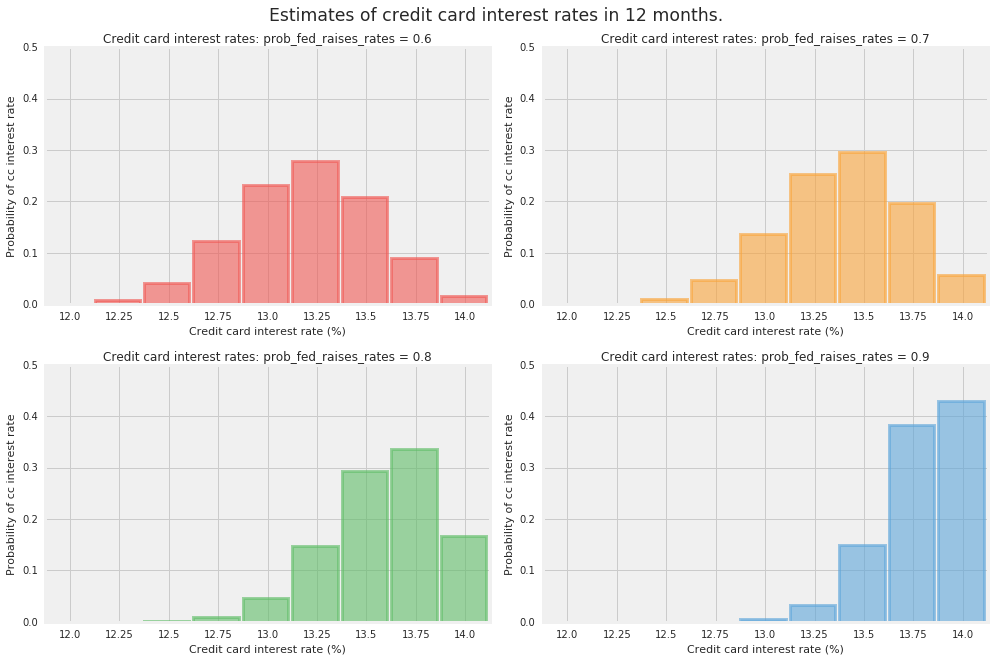 Google Colab में चलाएँ Google Colab में चलाएँ |  GitHub पर स्रोत देखें GitHub पर स्रोत देखें |
आइए कल्पना करें कि आप अब से एक वर्ष बाद अपने क्रेडिट कार्ड पर ब्याज दर का अनुमान लगाना चाहेंगे। मान लीजिए कि वर्तमान प्राइम दर 2% है और आपकी क्रेडिट कार्ड कंपनी आपसे 10% प्लस प्राइम शुल्क लेती है। मौजूदा अर्थव्यवस्था की मजबूती को देखते हुए, आपका मानना है कि फेडरल रिजर्व द्वारा ब्याज दरें बढ़ाने की संभावना अधिक है। फेड अगले बारह महीनों में आठ बार बैठक करेगा और या तो संघीय निधि दर को 0.25% बढ़ाएगा या इसे पिछले स्तर पर छोड़ देगा।
हम बारह महीने की अवधि के अंत में आपके क्रेडिट कार्ड की ब्याज दर को मॉडल करने के लिए द्विपद वितरण का उपयोग करते हैं। विशेष रूप से, हम निम्नलिखित मापदंडों के साथ TensorFlow संभाव्यता द्विपद वितरण वर्ग का उपयोग करेंगे: total_count = 8 (परीक्षणों या बैठकों की संख्या), probs = {.6, .7, .8, .9}, हमारे अनुमानों की सीमा के लिए फेड द्वारा प्रत्येक बैठक में संघीय निधि दर को 0.25% बढ़ाने की संभावना।
निर्भरताएँ और पूर्वापेक्षाएँ
TensorFlow संभाव्यता स्थापना सेटिंग्स
TFP_Installation = "Stable TFP"
if TFP_Installation == "Most Recent TFP":
!pip install -q tfp-nightly
print("Most recent TFP version installed")
elif TFP_Installation == "Stable TFP":
!pip install -q --upgrade tensorflow-probability
print("Up-to-date, stable TFP version installed")
elif TFP_Installation == "Stable TFP-GPU":
!pip install -q --upgrade tensorflow-probability-gpu
print("Up-to-date, stable TFP-GPU version installed")
print("(make sure GPU is properly configured)")
elif TFP_Installation == "Most Recent TFP-GPU":
!pip install -q tfp-nightly-gpu
print("Most recent TFP-GPU version installed")
print("(make sure GPU is properly configured)")
elif TFP_Installation == "TFP Already Installed":
print("TFP already installed in this environment")
pass
else:
print("Installation Error: Please select a viable TFP installation option.")
आयात और वैश्विक चर (इस सेल को चलाना सुनिश्चित करें)
from __future__ import absolute_import, division, print_function
warning_status = "ignore"
import warnings
warnings.filterwarnings(warning_status)
with warnings.catch_warnings():
warnings.filterwarnings(warning_status, category=DeprecationWarning)
warnings.filterwarnings(warning_status, category=UserWarning)
import numpy as np
import os
matplotlib_style = 'fivethirtyeight'
import matplotlib.pyplot as plt; plt.style.use(matplotlib_style)
import matplotlib.axes as axes;
from matplotlib.patches import Ellipse
%matplotlib inline
import seaborn as sns; sns.set_context('notebook')
notebook_screen_res = 'png'
%config InlineBackend.figure_format = notebook_screen_res
import tensorflow as tf
# Eager Execution
use_tf_eager = True
# Use try/except so we can easily re-execute the whole notebook.
if use_tf_eager:
try:
tf.compat.v1.enable_eager_execution()
except:
reset_session()
import tensorflow_probability as tfp
tfd = tfp.distributions
tfb = tfp.bijectors
def default_session_options(enable_gpu_ram_resizing=True,
enable_xla=False):
"""Creates default options for Graph-mode session."""
config = tf.ConfigProto()
config.log_device_placement = True
if enable_gpu_ram_resizing:
# `allow_growth=True` makes it possible to connect multiple
# colabs to your GPU. Otherwise the colab malloc's all GPU ram.
config.gpu_options.allow_growth = True
if enable_xla:
# Enable on XLA. https://www.tensorflow.org/performance/xla/.
config.graph_options.optimizer_options.global_jit_level = (
tf.OptimizerOptions.ON_1)
return config
def reset_session(options=None):
"""Creates a new global, interactive session in Graph-mode."""
if tf.executing_eagerly():
return
global sess
try:
tf.reset_default_graph()
sess.close()
except:
pass
if options is None:
options = default_session_options()
sess = tf.InteractiveSession(config=options)
def evaluate(tensors):
"""Evaluates Tensor or EagerTensor to Numpy `ndarray`s.
Args:
tensors: Object of `Tensor` or EagerTensor`s; can be `list`, `tuple`,
`namedtuple` or combinations thereof.
Returns:
ndarrays: Object with same structure as `tensors` except with `Tensor` or
`EagerTensor`s replaced by Numpy `ndarray`s.
"""
if tf.executing_eagerly():
return tf.contrib.framework.nest.pack_sequence_as(
tensors,
[t.numpy() if tf.contrib.framework.is_tensor(t) else t
for t in tf.contrib.framework.nest.flatten(tensors)])
return sess.run(tensors)
class _TFColor(object):
"""Enum of colors used in TF docs."""
red = '#F15854'
blue = '#5DA5DA'
orange = '#FAA43A'
green = '#60BD68'
pink = '#F17CB0'
brown = '#B2912F'
purple = '#B276B2'
yellow = '#DECF3F'
gray = '#4D4D4D'
def __getitem__(self, i):
return [
self.red,
self.orange,
self.green,
self.blue,
self.pink,
self.brown,
self.purple,
self.yellow,
self.gray,
][i % 9]
TFColor = _TFColor()
संभावनाओं की गणना करें
12 महीनों में संभावित क्रेडिट कार्ड ब्याज दरों की संभावनाओं की गणना करें।
# First we encode our assumptions.
num_times_fed_meets_per_year = 8.
possible_fed_increases = tf.range(
start=0.,
limit=num_times_fed_meets_per_year + 1)
possible_cc_interest_rates = 2. + 10. + 0.25 * possible_fed_increases
prob_fed_raises_rates = tf.constant([0.6, 0.7, 0.8, 0.9]) # Wild guesses.
# Now we use TFP to compute probabilities in a vectorized manner.
# Pad a dim so we broadcast fed probs against CC interest rates.
prob_fed_raises_rates = prob_fed_raises_rates[..., tf.newaxis]
prob_cc_interest_rate = tfd.Binomial(
total_count=num_times_fed_meets_per_year,
probs=prob_fed_raises_rates).prob(possible_fed_increases)
TF कोड निष्पादित करें
# Convert from TF to numpy.
[
possible_cc_interest_rates_,
prob_cc_interest_rate_,
prob_fed_raises_rates_,
] = evaluate([
possible_cc_interest_rates,
prob_cc_interest_rate,
prob_fed_raises_rates,
])
परिणाम विज़ुअलाइज़ करें
plt.figure(figsize=(14, 9))
for i, pf in enumerate(prob_fed_raises_rates_):
plt.subplot(2, 2, i+1)
plt.bar(possible_cc_interest_rates_,
prob_cc_interest_rate_[i],
color=TFColor[i],
width=0.23,
label="$p = {:.1f}$".format(pf[0]),
alpha=0.6,
edgecolor=TFColor[i],
lw="3")
plt.xticks(possible_cc_interest_rates_ + 0.125, possible_cc_interest_rates_)
plt.xlim(12, 14.25)
plt.ylim(0, 0.5)
plt.ylabel("Probability of cc interest rate")
plt.xlabel("Credit card interest rate (%)")
plt.title("Credit card interest rates: "
"prob_fed_raises_rates = {:.1f}".format(pf[0]));
plt.suptitle("Estimates of credit card interest rates in 12 months.",
fontsize="x-large",
y=1.02)
plt.tight_layout()


